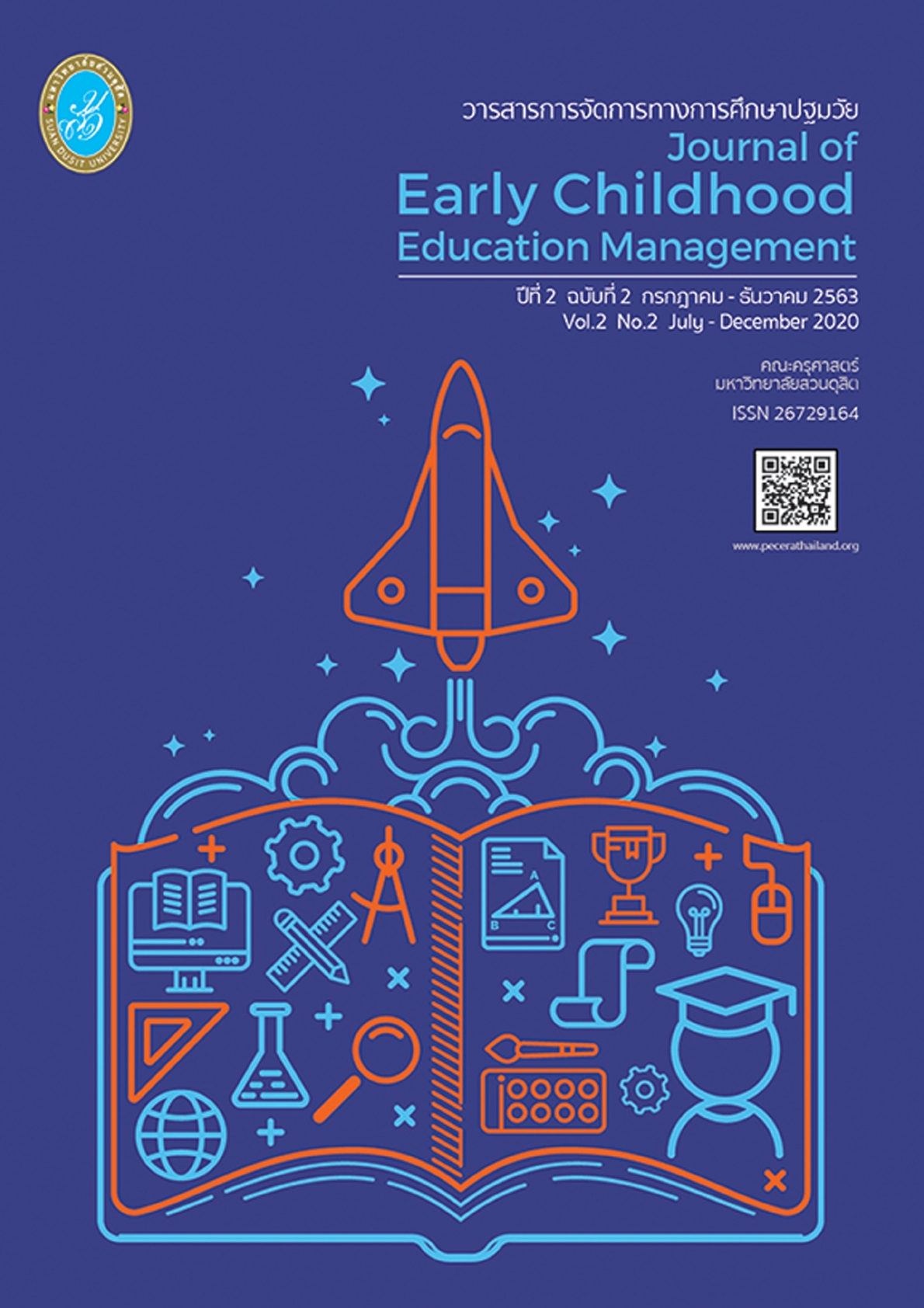Understanding Their World: Forming Classroom Accommodations and Sensory Activities for Children with Disabilities
คำสำคัญ:
Children with disabilities, Classroom accommodations, Sensory Activitiesบทคัดย่อ
Children learn by exploring, observing, discovering, experimenting, listening and asking questions. Daily activities can provide greater learning opportunities that allow children to enjoy trying a variety of sensations (e.g., such as dressing, brushing teeth, bathing with warm shower, climbing a tree, catching a ball, riding a bicycle, hugging a soft toy, or smelling the flowers). The more opportunities for children to explore sensory stimuli, the more benefits can be derived from developing cognitive, social, emotional, cognitive, physical, and motor domains more efficiently. However, some children have experienced challenges in their tolerance for sensory inputs and response. Children with disabilities who are associated with Sensory Processing Disorder (SPD) have neurological, biological, and sensory dysfunctions that affect how they perceive and respond to an environment unsystematically. SPD could have a negative influence on children’s development of academic learning, social friendship, emotional and mental health (e.g., anxiety, frustration, or depression). Hence, the teachers’ roles are important to support children’s unique strengths, adaptation, and understanding of different sensory environment stimuli by accommodating classroom activities to meet with their individual needs.
The purpose of this article is to gain better understanding of children with disabilities’ behaviors, who might also have symptoms of SPD such as Autism Spectrum Disorder (ASD) and other developmental disabilities, or Attention Deficit Hyperactivity Disorder (ADHD). The classroom accommodations and activities are also emphasized to promote children’s success and achievements in learning. This article highlights three primary areas, including: (1) Understanding Sensory Processing Disorder (2) Subtypes of Sensory Processing Disorder and (3) Classroom accommodations and activities for children with disabilities (sensory processing issues).
เอกสารอ้างอิง
Ahn, R. R., Miller L. J., Milberger, S. & McIntosh, D. N. (2004). Prevalence of parents'
perceptions of sensory processing disorders among kindergarten children. American Journal of Occupational Therapy, 58(3), pp. 287-293.
Anzalone, M. E. (2004). Sensory integration disorder. In Parker, S. Zuckerman, B.S. &
Augustyn, M. C. (Eds.) Developmental and Behavioral Pediatrics: a Handbook for
Primary Care Edition: 2. Lippincott Williams & Wilkins.
Case-Smith, J. (2005). Occupational therapy for children (5th ed.). St. Louis, MO: Elsevier.
Collins, B., & Miller, L. J. (2012). Sensory-based motor disorders: Postural disorder. Autism
Asperger’s Digest. Retrieved from https://www.spdstar.org/sites/default/files/
publications/3.%20Jul.-Aug.%202012%20-%20SBMD%2C%20PD_0.pdf
Connections Therapy Center. (September 2016). Your Child’s Olfactory System and SPD.
Retrieved from http://www.thectcenter.com/sensory-processing/your-childs-olfactory-system-and-spd/
Dunn, W. 2001. The sensations of everyday life: Empirical, theoretical, and pragmatic considerations. The American Journal of Occupational Therapy, 55(6), pp. 608–620.
Georgetown University Center for Child and Human Development. (2011). Contemporary practices in early intervention: Sensory processing disorder primer. Retrieved from https://www.teachingei.org/disabilities/primers/Sensory_Processing_Disorder.pdf
Goodman-Scott, E., & Lambert, S. F. (2015). Professional counseling for children with
sensory processing disorder. The Professional Counselor, 5(2), pp. 273–292.
doi:10.15241/egs.5.2.273
Lonkar, H. (2014). An overview of sensory processing disorder. (Honors Theses, Western
Michigan University, MI, USA), Retrieved from https://scholarworkd.wmich.edu/cgi/
viewcontent.cgi?article=3437&context=honors_theses
Magro, K. (December 2019). An Autism Poem. Retrieved from
https://www.facebook.com/kerry.magro
Miller, L. (2006). Sensational kids: Hope and help for children with sensory processing disorder. New York: the Penguin Group.
Miller, L. J., Coll, J. R., & Schoen, S. A. (2007). A randomized controlled pilot study of the effectiveness of occupational therapy for children with sensory modulation disorder. American Journal of Occupational Therapy, 61, pp. 228-238.
Miller, L. J., & Collins, B. (2012). Sensory solutions: Sensory discrimination disorder. Autism
Asperger’s Digest. Retrieved form https://www.spdstar.org/sites/default/files/ publications/5.%20Nov.-Dec.%202012%20-%20SDD.pdf
Morin, A. (December 2019). Classroom accommodations for sensory processing issues. Retrieved form https://www.understood.org/en/school-learning/partnering-with-childs-school/instructional-strategiest/at-a-glance-classroom-accommodations-for-sensory-processing-issues
Murray, M., Baker, P. H., Murray-Slutsky, C., & Paris, B. (2009). Strategies for supporting
the sensory-based learner. Preventing School Failure, 53(4), pp. 245-251.
National Research Council. (2001). Educating children with autism. The National Academies
Press, Washington, DC.
Oxford Health. (February 2014). Sensory processing: Children’s community occupational therapy. Retrieved form https://www.oxfordhealth.nhs.uk/wp content/uploads/ 2014/05/Sensory-Processing-presentation-February-2014.pdf
Phelan, S. (December 2019). Understanding the subtypes of sensory processing disorder. North Shore Pediatric Therapy. Retrieved form https://nspt4kids.com/health-topics- and-concerns/sensory-processing-disorder/understanding-subtypes-sensory-processing-disorder/
Preis, J., & McKenna, M. (2014). The effects of sensory integration therapy on verbal expression and engagement in children with autism. International Journal of Therapy and Rehabilitation, 21(10), pp. 476-486.
Prestia, K. (2004). Incorporate sensory activities and choices into the classroom. Intervention in School and Clinic, 39(3), pp. 172-175.
Richard, G. J. (2000). The source for treatment methodologies in autism. IL: LiguiSystems.
Rohman, J. M. (December 2019). Sensory accommodations for the classroom. Retrieved from http://wsascd.org/downloads/annual_conference/Sensory_Accomm_for_the_ Classroom.pdf
Seymore, A. (2016). Sensory accommodations in the classroom. Retrieved from https://glasshalffullot.com/wp-content/uploads/2017/03/Sensory-Adpatations-in-the-classroom.pdf
STAR institute for sensory processing disorder. (2017). Summary of sensory processing
disorder subtypes. Subtypes of SPD. Retrieved form https://www.spdstar.ort/basic/
subtypes-of-spd#postural
The American Occupational Therapy Association. (2015). Occupational therapy’s role in mental health promotion, prevention, & intervention with children & youth: Inclusion of children with disabilities. Retrieved from https://www.aota.org/~ /media/Corporate/
Files/Practice/Children/Inclusion-of-Children-With-Dicabilities-20150128.PDF
Travnik, A., & Krishnan, K. N. (December 2019). Guide to sensory processing. The University of Illinois Hospital. Retrieved from https://hospital.uillinois.edu/Documents/ICX/ ServiceLines/Rehabilitation/Guide%20to%20Sensory%20Processing.pdf
ดาวน์โหลด
เผยแพร่แล้ว
รูปแบบการอ้างอิง
ฉบับ
ประเภทบทความ
สัญญาอนุญาต
ลิขสิทธิ์ (c) 2022 คณะครุศาสตร์ มหาวิทยาลัยสวนดุสิต

อนุญาตภายใต้เงื่อนไข Creative Commons Attribution-NonCommercial-NoDerivatives 4.0 International License.
ลิขสิทธิ์ต้นฉบับที่ได้รับการตีพิมพ์ในวารสารการจัดการทางการศึกษาปฐมวัย ถือเป็นกรรมสิทธิ์ของคณะครุศาสตร์ มหาวิทยาลัยสวนดุสิต ห้ามผู้ใดนำข้อความทั้งหมดหรือบางส่วนไปพิมพ์ซ้ำ เว้นแต่จะได้รับอนุญาตอย่างเป็นลายลักษณ์อักษรจากคณะครุศาสตร์ มหาวิทยาลัยสวนดุสิต นอกจากนี้ เนื้อหาที่ปรากฎในบทความเป็นความรับผิดชอบของผู้เขียน ทั้งนี้ไม่รวมความผิดพลาดอันเกิดจากเทคนิคการพิมพ์




